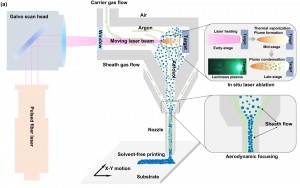
Modern society generates an astonishing amount of data – thanks in part to the regular use of personal laptops, cell phones and smart wearables – causing information transmission rates to skyrocket in recent years. This is pushing the bandwidth of wired and radiofrequency-based (RF) communication protocols to breaking point, prompting the industry to seek out novel solutions that can remove data bottlenecks. Free space optical communication – the use of lasers to wirelessly transmit information at unprecedented speeds – is one approach that is gaining traction as a high performance alternative to conventional technologies. This article discusses the benefits and applications of this promising communication method, as well as diving into the intricate mechanisms that make it possible.
From dial-up to broadband
The early 1990s saw the widespread rollout of dial-up internet which, although revolutionary at the time, suffered from slow data transfer rates due to inherent bandwidth restrictions. Thankfully, this sluggish technology was succeeded by comparatively rapid broadband services, operating at much wider bandwidths to squeeze the most out of traditional phone lines. Progress didn’t stop there though, and copper connections were eventually replaced with optical fibers to offer previously unimaginable data transfer speeds, paving the way for effortless movie streaming, video calling and online gaming, among arguably more important things.
Globally connected
Optical fiber connections are now virtually everywhere, with a vast trans-continental network allowing rapid and reliable communication between almost any two points on the globe. However, ground-satellite and satellite-satellite communications still rely heavily on RF transmissions to beam information through the Earth’s atmosphere and across the vacuum of space – since the wired linking of satellites is clearly not an option. RF technologies use low-frequency radiation as a carrier wave, which is extremely useful in ground-ground telecommunications, because it allows signals to travel relatively undisturbed through solid objects opaque to visible light. However, this has very little benefit for satellite uplinks, as the signal path is normally unhindered, and the low energy state of RF waves limits the amount of information they can carry. RF transmissions are also inherently unfocusable, with wide beam divergence angles causing significant power loss over long distances, resulting in most of the transmitted energy never reaching the receiver. This is especially true in ground-satellite and satellite-satellite communication, where signals must travel thousands of miles to reach the intended target.
In with the new
The industry has been looking at options to overcome the inherent shortcomings of RF-based communication methods for some time, and a high energy line-of-sight technique known as free space optical (FSO) communication is emerging as a leading solution. This method uses infrared or optical lasers as its vehicle of choice, enabling vast amounts of information to be encoded into high frequency carrier waves. Additionally, lasers are inherently more focusable than traditional RF signals – meaning a greater proportion of the transmitted energy reaches the receiver – resulting in much improved energy efficiency, bandwidth and data transfer speeds. Low laser divergence angles also make FSO communications much harder to intercept than RF signals – requiring any rogue recipient to be located within the extremely narrow beam cross section – making it ideal for sensitive applications requiring additional security.
Obstacles to overcome
Despite the many benefits offered by FSO communication, there are also some obstacles that can hinder its performance. Firstly, it requires the perfect alignment of signal transmitters and receivers, which is no mean feat considering the astronomical distances involved in ground-satellite and satellite-satellite communication. Secondly, any signals transmitted through the air are susceptible to random phase and amplitude fluctuations from atmospheric turbulence, as well as severe signal attenuation caused by cloud cover, fog and dust storms. Finally, FSO is also extremely sensitive to beam drift from building sway, vibration, thermal expansion of components and subpar tracking systems. Put simply, FSO is a much more efficient means of communication when deployed in favorable conditions, but its sensitivity to environmental perturbations make it less robust than RF alternatives.
Actively aligned
Fortunately, technologies have been developed that can overcome such disturbances. Fast response tip/tilt mirror systems – or fast steering mirrors (FSMs) – can provide dynamic real-time laser stabilization, keeping the beam precisely on target at all times. Piezo-based positioning technologies generally have faster response times than equivalent galvo-scanners and voice-coil driven systems, making them well suited to such highly dynamic applications. These instruments have already been launched into space on the Solar Orbiter – a satellite space probe developed in a joint project between the European Space Agency and NASA – where they functioned at extreme temperatures in a high vacuum. Although exhibiting slower response times than piezo-based alternatives, electromagnetic drives can also be used for FSO communications, and are perfect for applications requiring large steering angles. State-of-the-art multi-axis solutions – like those engineered by Physik Instrumente – can integrate pitch, roll and piston motion into one device with a single mirror. This is important in many precision optics applications, as it allows laser polarization direction to remain unchanged – with sub-millisecond response times, nanoradian range resolution, and deflection angles of up to three degrees.
Into the unknown
Technologies like FSO that enable rapid, high bandwidth data transfer are sure to play a pivotal role during future manned and robotic expeditions to the vast reaches of our solar system – and maybe someday even far beyond – as these endeavors will be reliant on seamless two-way communication with Earth. Swathes of scientific data, images, videos and telemetry will need to be beamed back home with minimal power loss, and spacecraft will simultaneously need to receive guidance updates, software patches and other critical data from ground control. Space agencies are sure to be aiming for communication solutions with transmission rates that are orders of magnitude higher than current technologies can provide, all without breaching weight, envelope and power consumption limits. However, no matter the bandwidths involved, communications are still limited by a universal constant – the speed of light – making real-time communication with a spacecraft in interstellar space simply impossible. It is therefore more likely that onboard artificial intelligence systems will be used to take care of time-critical decisions, leaving laser communication technologies to beam back valuable and potentially paradigm-shifting scientific data.
Incorporating state-of-the-art positioning technologies
FSO technologies can offer fast and secure data transfer between two points in line-of-sight, whether they are meters or light-minutes apart, enabling efficient ground-ground, ground-satellite and satellite-satellite communication with minimal power loss. As well as having the potential to revolutionize earth-based applications, future space exploration missions will likely be reliant on these robust, high speed methods of data transfer, as we explore further than we ever have before. However, electromagnetic and piezo-driven FSM systems capable of rapid and dynamic compensation will be essential if lasers are to be kept on-target in the presence of vibration, thermal drift and atmospheric disturbances – as well as perturbations in spacecraft orbits and flight paths. Only by incorporating these state-of-the-art positioning technologies can the communications sector deliver a future of unimaginable data transfer speeds, while giving space agencies the tools needed to explore the furthest reaches of the solar system and beyond.
Written by Warren Harvard, Country Manager UK, and Scott Jordan, Head of Photonics, Physik Instrumente































 Back to Features
Back to Features




























